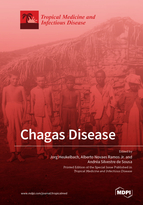Chagas Disease
A special issue of Tropical Medicine and Infectious Disease (ISSN 2414-6366). This special issue belongs to the section "Neglected and Emerging Tropical Diseases".
Deadline for manuscript submissions: closed (20 November 2020) | Viewed by 46624
Special Issue Editors
Interests: public health; tropical neglected diseases; epidemiology
Special Issues, Collections and Topics in MDPI journals
Interests: public health; epidemiology; tropical neglected diseases; infectious diseases
Special Issue Information
Dear Colleagues,
About 110 years after its discovery, Chagas disease persists as a critical public health problem, having crossed the boundaries of Latin America. It is a neglected tropical disease, as evidenced by the ongoing scientific evidence gaps, the difficulty of incorporating new diagnostic and treatment technologies into the market, and the public health failures to ensure timely access to diagnosis and treatment associated with the development of consistent surveillance and control actions. As a result, there is a high burden of morbidity and mortality, and poor quality of life, poverty, stigma, as well as the fear of death persist for the affected people.
In line with the 72nd World Health Assembly, which approved the designation of 14th April as World Chagas Disease Day, this Special Thematic Issue aims to contribute to greater information dissemination and awareness about Chagas disease. This Special Issue shall focus inter alia on critical-reflective and innovative analyses of the epidemiology of Chagas diseases in endemic and non-endemic areas, Trypanosoma cruzi transmission dynamics, the role of sylvatic and domestic reservoirs, new surveillance and control strategies, advances in the diagnosis and treatment of T. cruzi infection, T. cruzi diversity and the natural history of Chagas disease, the management of clinical complications, predictors of disease progression, and physical and psychosocial rehabilitation. Studies performing economic analyses, successful experiences implemented in the field, and approaches on social and human sciences are also welcome.
Prof. Dr. Jorg Heukelbach
Prof. Dr. Alberto Novaes Ramos Jr.
Prof. Dr. Andrea Silvestre de Sousa
Guest Editors
Manuscript Submission Information
Manuscripts should be submitted online at www.mdpi.com by registering and logging in to this website. Once you are registered, click here to go to the submission form. Manuscripts can be submitted until the deadline. All submissions that pass pre-check are peer-reviewed. Accepted papers will be published continuously in the journal (as soon as accepted) and will be listed together on the special issue website. Research articles, review articles as well as short communications are invited. For planned papers, a title and short abstract (about 100 words) can be sent to the Editorial Office for announcement on this website.
Submitted manuscripts should not have been published previously, nor be under consideration for publication elsewhere (except conference proceedings papers). All manuscripts are thoroughly refereed through a single-blind peer-review process. A guide for authors and other relevant information for submission of manuscripts is available on the Instructions for Authors page. Tropical Medicine and Infectious Disease is an international peer-reviewed open access monthly journal published by MDPI.
Please visit the Instructions for Authors page before submitting a manuscript. The Article Processing Charge (APC) for publication in this open access journal is 2700 CHF (Swiss Francs). Submitted papers should be well formatted and use good English. Authors may use MDPI's English editing service prior to publication or during author revisions.
Keywords
- Chagas disease
- American Trypanosomiasis
- Trypanosoma cruzi infection
- Neglected tropical disease
- Public health
- Epidemiology
- Prevention and control
- Surveillance
- Clinical research
- Social science









